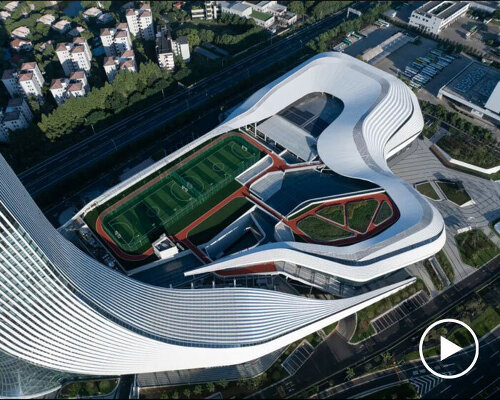line+ unveils the Multifunctional Xinchang Globular Center
The Xinchang Globular Center in Zhejiang Province, China, designed by Dr. Zhu Peidong and the team at line+ studio, has been completed and opened to the public. As one of the province’s key ‘4+1’ major projects, the facility is conceived not only as a conventional event-driven stadium but as a mixed-use ‘sports mall’ that combines athletic, commercial, and public programs within a single operational framework. The building meets professional standards for international competitions while functioning as a year-round activity center for local residents.
Positioned along Xinchang’s northern development axis near the new high-speed rail station, the project occupies a site previously reserved for infrastructure and surrounded by former industrial buildings. The design reactivates this area by introducing a 120,000 sqm complex that supports both professional events and daily community use. Given the scale of the project, comparable to major-city sports venues, the design strategy extends beyond hosting competitions to establishing a sustainable operational model for the city.
The ‘sports mall’ model addresses common challenges in venue utilization, particularly in county-level cities where irregular event cycles can lead to high operating pressures. The design integrates dining, retail, entertainment, hospitality, and exhibition functions around sports as the primary program. This allows the facility to support large-scale events while maintaining consistent foot traffic and public engagement throughout the day.
all images by Chen Xi Studio, line+
Functional stacking and flexible planning define the layout
The architectural team at line+ studio organized the spatial layout following three interconnected principles. First, the design prioritizes normalization, ensuring that spaces support daily fitness, leisure, and regular public use rather than relying solely on major events. This is reinforced by a functional mix in which commercial and social programs complement athletic facilities and address gaps in the surrounding urban amenities. Finally, these strategies enable a high degree of operational flexibility, allowing the building to shift between professional competitions, large public events, performances, and everyday civic activities.
The compact site required dense functional stacking. The facility includes a 5,000-seat gymnasium, multiple small-ball training halls, commercial spaces, a ballroom, and a 19-story athlete hotel. A new vehicular ramp links the national highway directly to the site, while internal circulation separates hotel, logistics, event, and public flows. The main public arrival zone on the north connects directly to the gymnasium, training halls, and plaza; the hotel occupies the quieter south edge facing the river. Five major volumes, the main gymnasium, small-ball halls, training halls, and hotel, are connected by a central atrium functioning as an interior urban street. Retail and dining elements line this axis, linking the north and south entries and ensuring consistent activity.
Because different sports demand distinct, clear heights and floor layouts, the design adopts an ‘elastic grid’ system that enables each hall to be reconfigured for multiple event types. The main gymnasium, measuring roughly 16,000 sqm, can transform to host 12 badminton courts, three basketball courts, 14 table tennis courts, or a single tennis court, and includes 5,000 retractable seats. The 7,900-sqm training hall accommodates 24 badminton courts or two tennis courts and incorporates a basement-level gym and four-lane pool. A dedicated 6,100-square-meter table tennis hall offers dual-height spaces suitable for both table tennis and badminton training. Tying the entire complex together, a continuous rooftop spans all volumes and is programmed with a soccer field, running track, and viewing platform, remaining accessible at all hours through a network of external ramps.
Landscape-Inspired Architecture Anchors Xinchang’s Sports Hub
The architectural expression references the landscape character of the region, drawing from mountain contours and water movement. A continuous massing strategy and horizontal rhythm define the waterfront interface, while the hotel tower forms a new vertical marker on the city’s northern skyline. Perforated aluminum panels and metal grilles generate varied light conditions by day and create an illuminated presence at night. Large-span trusses and a frame-core-tube structural system allow flexible interior volumes while maintaining construction efficiency. The main gymnasium spans 75.9 meters; training halls span 30–36.5 meters, depending on program requirements.
Since opening, the Xinchang Globular Center has hosted major domestic competitions, including the China Badminton Masters and National Table Tennis Championships, and will host an international snooker event in 2025. The center supports a regular schedule of weekly and monthly events, with attendance surpassing 220,000 and significant economic impact reported. By combining sports, leisure, and commercial functions under one roof, the project operates as a continuous urban system rather than an event-specific venue. It demonstrates a scalable model for cities seeking to integrate competitive sports infrastructure with broader urban development goals.
project info:
name: Xinchang Globular Center
architect: line+ studio | @lineplus_studio
location: Xinchang, Shaoxing, Zhejiang Province, China
gross floor area: 121,132 sqm
chief architect/project principal: Zhu Peidong
conceptual/competition phase project leader: Xing Mingquan
conceptual/competition phase design team: Bao Wangtao, Liang Shiqiu, Zhou Wenyu, Liu Xiangjun, Sun Jiahao
competition/implementation phase project leader: Hu Runzhi, Xing Mingquan
competition/implementation phase design team: Bian Qian, Zhao Censen, Bao Wangtao, Duan Xiajing, Xu Zifeng, Zhang Daozheng, Tao Xufeng, Guo Zhenghao
interior conceptual design team: Jin Yuting, Ye Xin, Yu Jun, Zheng Liu, Zhu Yingyue, Mao Ling
landscape conceptual design team: Li Shangyang, Rao Feier
client: Xinchang Public Service Group Co., Ltd.
collaborating design institute: Huahui Engineering Design Group Co., Ltd.
curtain wall design: Zhongnan Curtain Wall
photographer: Chen Xi Studio | @xichen_photo, line+
designboom has received this project from our DIY submissions feature, where we welcome our readers to submit their own work for publication. see more project submissions from our readers here.
edited by: christina vergopoulou | designboom
The post aluminum panels wrap landscape-inspired undulating facade of sports mall by line+ appeared first on designboom | architecture & design magazine.

